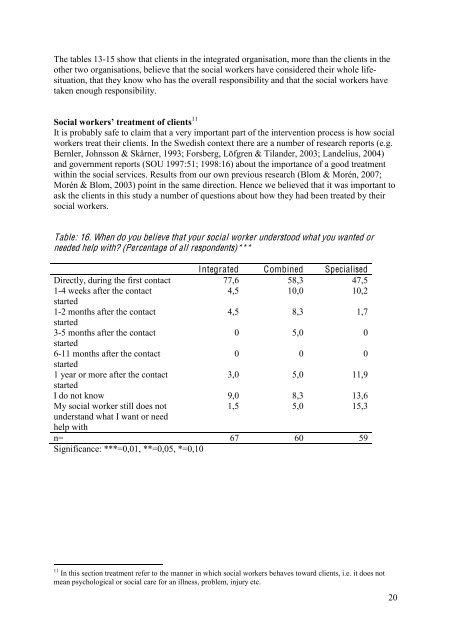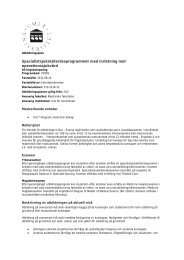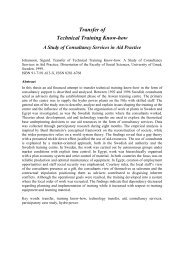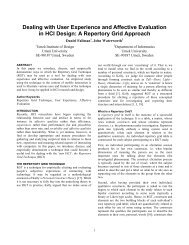Organisational Structure as Barrier or Support in the Personal Social ...
Organisational Structure as Barrier or Support in the Personal Social ...
Organisational Structure as Barrier or Support in the Personal Social ...
You also want an ePaper? Increase the reach of your titles
YUMPU automatically turns print PDFs into web optimized ePapers that Google loves.
The tables 13-15 show that clients <strong>in</strong> <strong>the</strong> <strong>in</strong>tegrated <strong>or</strong>ganisation, m<strong>or</strong>e than <strong>the</strong> clients <strong>in</strong> <strong>the</strong>o<strong>the</strong>r two <strong>or</strong>ganisations, believe that <strong>the</strong> social w<strong>or</strong>kers have considered <strong>the</strong>ir whole lifesituation,that <strong>the</strong>y know who h<strong>as</strong> <strong>the</strong> overall responsibility and that <strong>the</strong> social w<strong>or</strong>kers havetaken enough responsibility.<strong>Social</strong> w<strong>or</strong>kers’ treatment of clients 11It is probably safe to claim that a very imp<strong>or</strong>tant part of <strong>the</strong> <strong>in</strong>tervention process is how socialw<strong>or</strong>kers treat <strong>the</strong>ir clients. In <strong>the</strong> Swedish context <strong>the</strong>re are a number of research rep<strong>or</strong>ts (e.g.Bernler, Johnsson & Skårner, 1993; F<strong>or</strong>sberg, Löfgren & Tilander, 2003; Landelius, 2004)and government rep<strong>or</strong>ts (SOU 1997:51; 1998:16) about <strong>the</strong> imp<strong>or</strong>tance of a good treatmentwith<strong>in</strong> <strong>the</strong> social services. Results from our own previous research (Blom & M<strong>or</strong>én, 2007;M<strong>or</strong>én & Blom, 2003) po<strong>in</strong>t <strong>in</strong> <strong>the</strong> same direction. Hence we believed that it w<strong>as</strong> imp<strong>or</strong>tant to<strong>as</strong>k <strong>the</strong> clients <strong>in</strong> this study a number of questions about how <strong>the</strong>y had been treated by <strong>the</strong>irsocial w<strong>or</strong>kers.Table: 16. When do you believe that your social w<strong>or</strong>ker understood what you wanted <strong>or</strong>needed help with? (Percentage of all respondents)***Integrated Comb<strong>in</strong>ed SpecialisedDirectly, dur<strong>in</strong>g <strong>the</strong> first contact 77,6 58,3 47,51-4 weeks after <strong>the</strong> contact4,5 10,0 10,2started1-2 months after <strong>the</strong> contact4,5 8,3 1,7started3-5 months after <strong>the</strong> contact0 5,0 0started6-11 months after <strong>the</strong> contact0 0 0started1 year <strong>or</strong> m<strong>or</strong>e after <strong>the</strong> contact3,0 5,0 11,9startedI do not know 9,0 8,3 13,6My social w<strong>or</strong>ker still does not1,5 5,0 15,3understand what I want <strong>or</strong> needhelp withn= 67 60 59Significance: ***=0,01, **=0,05, *=0,1011 In this section treatment refer to <strong>the</strong> manner <strong>in</strong> which social w<strong>or</strong>kers behaves toward clients, i.e. it does notmean psychological <strong>or</strong> social care f<strong>or</strong> an illness, problem, <strong>in</strong>jury etc.20
















